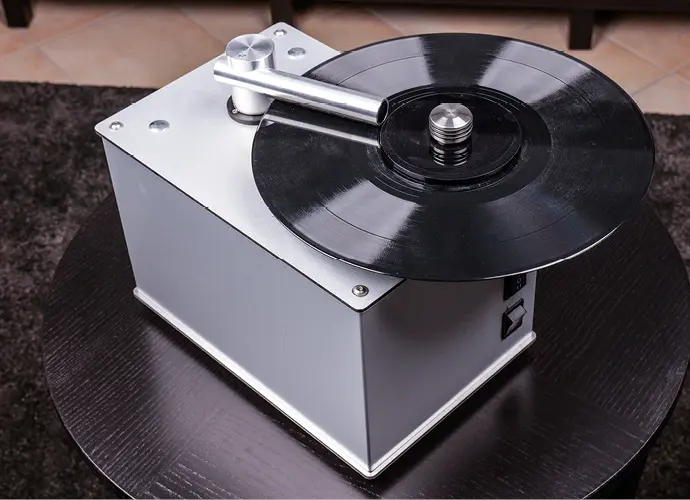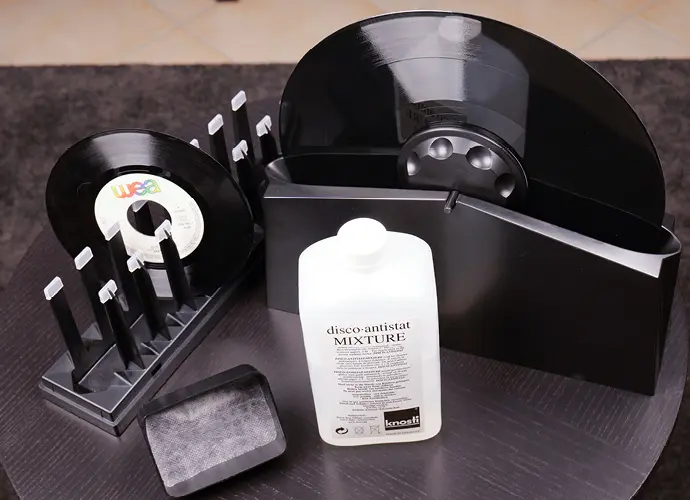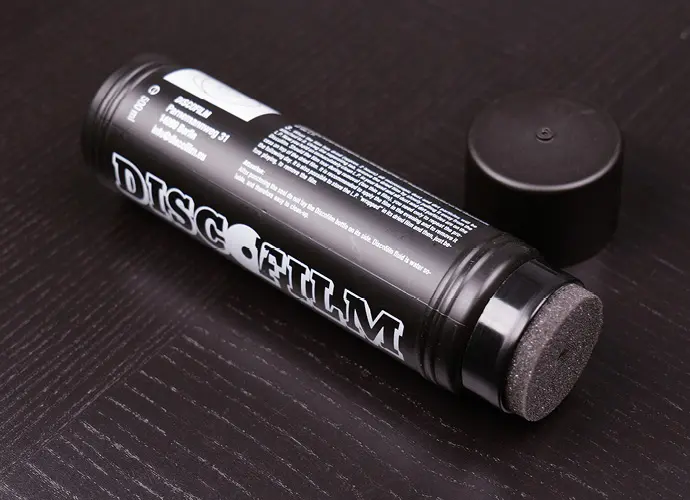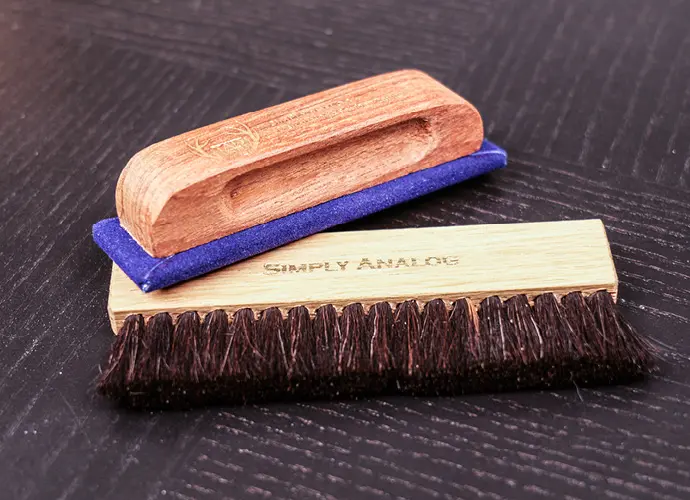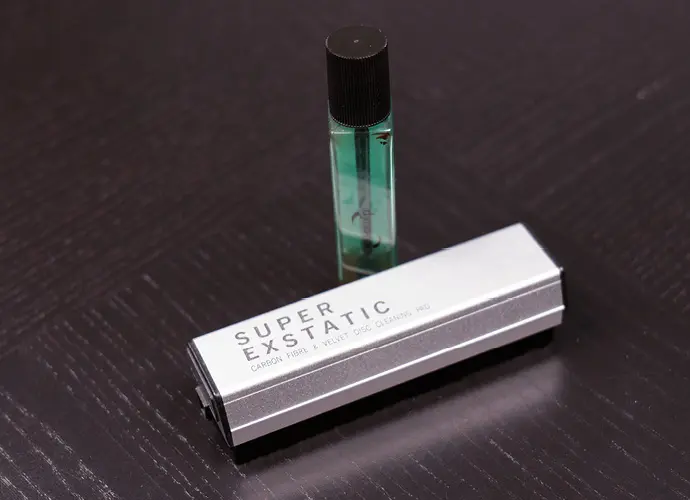Record cleaning
The boom in vinyl records has continued unabated for years, with more and more fans of the black disks, including younger hi-fi enthusiasts. But if it crackles or pops when the records are played, the high-fidelity fun soon comes to an end.
Perfect sound: How record cleaning affects the quality of your music playback
Fresh out of the sleeve, a record offers a clean sound experience. But over time, dust and other dirt particles get onto the panel. Then you need a suitable cleaning device. But what helps best?
To understand why even the smallest impurities become a major problem, we need to take a closer look at the record. The music information is stored in 40 µm narrow grooves. A tiny, polished diamond scans the information and transmits the vibrations via the needle carrier to the inside of the pickup system.
In the widely used moving magnet system, an equally tiny magnet sits at the end of the needle carrier, vibrating between fine copper wire coils. In this way, electrical impulses are generated from the vibrations. However, these signals are so weak that they must first be amplified via a phono preamplifier before they are passed on to the actual amplifier. Due to this double amplification, even the finest particles produce clearly audible and sometimes very loud noise.

Affordable basic method
The classic brush is the simplest and cheapest solution for removing annoying dust from the record. These brushes are available in all conceivable designs and a wide variety of bristle materials. Carbon fiber brushes are the most widely used. These are available from 10 euros upwards, often also in a set with a needle cleaner (also highly recommended). The carbon fibers are very thin and therefore reach deep into the groove. As the fibers are very flexible, the vinyl is protected during cleaning. If you want it even gentler, you can use a brush with real goat hair, which is available from Greek accessories specialist Simply Analog for around 20 euros. Goat hair is somewhat thicker than carbon fibers, but cleans more gently. A little tip: Goat hair brushes are also ideal for gently removing dust from the rack and hi-fi components. However, you should not use the same brush for vinyl care and cleaning the system. Velvet brushes clean even more thoroughly and are ideal for cleaning in two stages - first goat hair or carbon fiber, then velvet.
Cumbersome, but good
Cleaning with Discofilm is much more thorough, but much more time-consuming. This cleaning agent has been available for decades in the distinctive black bottles. The liquid, which has a consistency reminiscent of honey, is applied to the record with a sponge until thick, but not too thick. The cap of the bottle serves as a holder for the record. Finally, place a piece of adhesive tape over the edge to create a kind of peel-off tab. Now allow the liquid to dry for 8 - 15 hours until a solid film is formed. This is then peeled off the panel like a film, removing any dirt or dust from the panel. It takes a little practice to create an even and sufficiently thick film that does not tear during removal. But cleaning with Discofilm is actually one of the best methods. There are professional photographers who use Discofilm to clean the sensitive image sensors of their cameras. Of course, this is nothing for impatient record listeners who want to clean and check their flea market purchases immediately.
The best cleaning
If you prefer to clean your black disks quickly and thoroughly, there's no getting around a disk washer. However, the decision is not easy, as they are available in numerous variants and price ranges. We start with a classic: The Disco-Antistat from Knosti is available online for around 60 euros. It is cheap and good, but not fast and a lot of manual work is required. The cleaning fluid is placed in an immersion bath with brush inserts. The record is clamped in a holder and placed on the immersion bath. The record is turned by hand and then placed in a rack to dry (first allow to drain well). After cleaning one or more records, the liquid is tipped back into the bottle using a funnel and a filter fleece. When cleaning, make sure that the paper label of the plate does not get wet. But the result is something that’s attractive to the eye and, above all, to the ear. Record washing machines with suction are faster and better. The record is clamped onto a small turntable.
Some cleaning fluid, usually consisting of distilled water, isopropanol and surfactants, is then applied to the rotating plate. The liquid is distributed with a brush and then extracted with a suction arm. Velvet sealing lips ensure that the panel is not damaged. This is not a particularly audiophile process, as some models reach the noise level of a jet taking off. The advantage of this method: The dirt is sucked off together with the liquid and the panel is dry more quickly. Simpler models such as the VC-E from Pro-Ject start at 400 euros, but you can also spend 5,000 euros on a Clearaudio Double Matrix Professional Sonic, which cleans both sides simultaneously. A few models clean the plates with ultrasound. In these models, the cleaning fluid is made to vibrate at around 40 kHz. As a result, the dirt particles dissolve completely without mechanical influences. As a rule, these ultrasonic plate cleaners are somewhat more expensive and the cleaning and drying of the plates takes longer than with their suction counterparts.
My conclusion
If you listen to a lot of records and like to rummage through flea markets in search of black gold, there's no getting around a record washing machine.
However, an inexpensive model will also do for a start, as these already offer a very good cleaning performance.
Discofilm and the Knosti Disco-Antistat are more for occasional listeners.
The good old record brush will do for cleaning in between.
By the way:
Every good record store offers a professional cleaning service for a small amount of money.
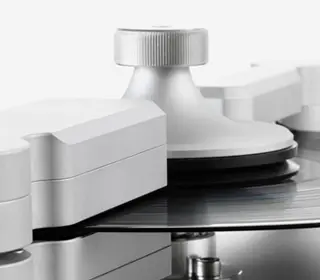
Guest article: Record cleaning
How record cleaning affects the quality of your music playback. Record cleaning from "cheap" to high-end.
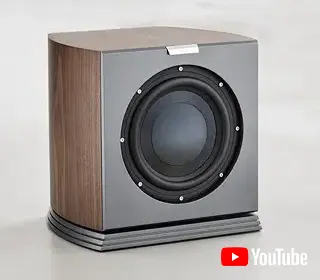
Guest article: Setting up active subwoofers correctly
The correct positioning of subwoofers is often discussed. Unfortunately, all too rarely about how how to set them when they are already positioned in the best possible way .

Guest article: Improving room acoustics with on-board resources
Does your music room sound too bright? Then improve the acoustics in just a few steps. But please avoid egg cartons. They belong in the fridge, not on the wall ;-)

Guest article: Optimizing streaming
Streaming is very easy thanks to a range of apps and smart streaming players, but there are pitfalls and a lot of potential for optimization if you want it to sound really good.

